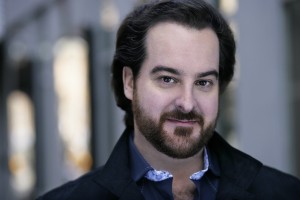ORANGE COUNTY GOES GREEN, I.E. VERDI
Opera is alive and well in Orange County! Since the demise of Opera Pacific (1985-2008), Pacific Symphony, aided by Pacific Chorale, has emerged as the company’s most likely heir. Its current production of Verdi’s La Traviata is the final production of a successful three-year experiment initiated in 2010 by Pacific Symphony conductor Carl St. Clair. It was preceded by two Puccini operas: La Bohème (2012) and Tosca (2013). Now that the experiment is over, operatic offerings appear to be a permanent feature of the repertoire. Bizet’s Carmen is already slated for the 2014-2015 season. Pacific Symphony’s traditional repertoire continues the path trod by Opera Pacific and contrasts nicely with nearby Long Beach Opera’s avant-garde assault.
 Based on the novel/play La Dame aux Camélias by Alexandre Dumas, La Traviata comes from Giuseppe Verdi’s middle years. Composed in 1853, La Traviata is a tragic love story in three acts. The first act introduces the opera’s two principal characters: the Parisian courtesan Violetta Valery and her lover Alfredo Germont. At the party that Violetta throws to celebrate her return to health, Germont declares his love for her. The second act finds the two living together in a country house outside Paris until Alfredo’s father Giorgio arrives and convinces Violetta that she must leave Alfredo. Her liaison with Alfredo is endangering the engagement of Alfredo’s sister, Giorgio declares. Violetta dutifully abandons Alfredo, who, not knowing the role played by his father, subsequently insults her at a party. In the final act, the two lovers are reconciled on Violetta’s deathbed just before Violetta’s (anti)climactic death. It is a poignant story that perhaps expresses something of the composer’s own fraught love life, since Verdi lived with the soprano Giuseppina Strepponi for more than a decade before they finally married in 1859.
Based on the novel/play La Dame aux Camélias by Alexandre Dumas, La Traviata comes from Giuseppe Verdi’s middle years. Composed in 1853, La Traviata is a tragic love story in three acts. The first act introduces the opera’s two principal characters: the Parisian courtesan Violetta Valery and her lover Alfredo Germont. At the party that Violetta throws to celebrate her return to health, Germont declares his love for her. The second act finds the two living together in a country house outside Paris until Alfredo’s father Giorgio arrives and convinces Violetta that she must leave Alfredo. Her liaison with Alfredo is endangering the engagement of Alfredo’s sister, Giorgio declares. Violetta dutifully abandons Alfredo, who, not knowing the role played by his father, subsequently insults her at a party. In the final act, the two lovers are reconciled on Violetta’s deathbed just before Violetta’s (anti)climactic death. It is a poignant story that perhaps expresses something of the composer’s own fraught love life, since Verdi lived with the soprano Giuseppina Strepponi for more than a decade before they finally married in 1859.
Due to the physical constraints of the Segerstrom Concert Hall, operatic productions are semi-staged. In other words, there are costumes and props, but no sets. In the foreground is a narrow stage, which is just large enough to accommodate as many as two or three dozen actors, singers and dancers during the second act’s party scene. The middle ground is held by the orchestra, giving it a prominence lacking in  most venues. This has the happy effect of enabling the audience to appreciate Verdi’s colorful score and memorable melodies more easily. Far up above the orchestra, but below the organ, the 140-member Pacific Chorale underscores the opera’s more festive scenes in Acts 1 and 2 with a sound that is unified, powerful and jovial.
most venues. This has the happy effect of enabling the audience to appreciate Verdi’s colorful score and memorable melodies more easily. Far up above the orchestra, but below the organ, the 140-member Pacific Chorale underscores the opera’s more festive scenes in Acts 1 and 2 with a sound that is unified, powerful and jovial.
The strength of the current production lies in the consummate artistry of the two Cuban-American leads: soprano Elizabeth Caballero as Violetta and tenor Rolando Sanz as Alfredo. Both have voices that exhibit a rich, rounded sound that is utterly smooth and mellow; there’s nothing sharp or shrill about them. Caballero, in particular, shows perfect control, even in the upper range. Whereas the voice naturally wants volume to support the high notes, she can manage them softly and confidently as well, especially during her breathtaking first-act arias “Ah, fors’è lui” and “Sempre libera” and emotional third-act aria “Addio del passato.” Above all, these tours-de-force beautifully show off Caballero’s versatility in a role that combines coloratura, lyric, and dramatic singing.
A number of actors and dancers of varying quality fill out the remainder of the cast. Although the audience clearly thought highly of baritone Mark Delavan as Giorgio Germont, Alfredo’s meddling father, this reviewer found his voice hollow on the whole. Also lacking was the bass of Michael Gallup as Dr. Grenvil, whose throat occasionally sounded clogged with mothballs. More enjoyable were the bit parts played by baritone Jamie Offenbach as the imperious Baron Douphol and by mezzo-soprano Jamie Van Eyck as Violetta’s friend Flora. Adding welcome variety  to the second act were dancers Steve Rosa and Christine Gerena as matador and gypsy, respectively.
to the second act were dancers Steve Rosa and Christine Gerena as matador and gypsy, respectively.
Director A. Scott Parry splendidly envisions La Traviata on the limited stage but for one anachronistic flaw. It is not a fatal flaw, but one that shows an error of taste or judgment. While audiences take their seats and wait for the opera to start, a woman lies in a modern hospital bed next to a TV. It shows a black-and-white film that soon ends, revealing an ending which mirrors that of La Traviata. She and her nurse are ushered out during the orchestra’s prelude (there is no overture). What appears as a simple way of depicting Violetta’s background, which is only hinted at in the libretto, is reintroduced during the third act. This time the woman in the bed sings and is revealed to be Elizabeth Caballero as Violetta. Annina, her maidservant, appears in hospital scrubs, while Dr. Grenvil is now attired in a white coat and lacks his earlier side whiskers. Yet, Alfredo and Giorgio in their earlier nineteenth century costumes ruins the consistency of the modern setting. These are strange artistic choices that add nothing to the enjoyment or understanding of Verdi’s opera.
The hall might not be the best venue for operatic performances, but Pacific Symphony shows that it can work. It can also help audiences appreciate works in new ways, by making the music more prominent and by simplifying the staging. Fortunately, the company does not go completely abstract, mostly retaining period costume and sets. The result is an accomplished production of Verdi’s magnificent love tragedy, one that reveals Caballero as a rising star. La Traviata portends well for the future of opera in Orange County.
no production photos available
publicity photos courtesy of Pacific Symphony
La Traviata
Pacific Symphony
Renee and Henry Segerstrom Concert Hall in Costa Mesa
scheduled to end on February 25, 2014
for tickets, call 714-755-5799 or visit www.pacificsymphony.org
